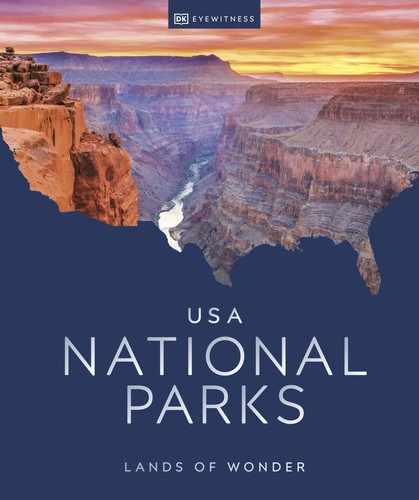
Utah
ARCHES
ESTABLISHED 1971
Beloved for its otherworldly rock formations and the brilliant hues of the landscape, Arches is one place everyone should visit at least once in their lives.
Justifiably famous, the spectacular rock formations and vivid colors at Arches make it an artists’ and photographers’ dream. The landscape can be harsh and forbidding, especially in the midday sun, but it rewards exploration as long as you’re prepared with the essentials of hats and lots of water. The park is surprisingly accessible, too, with hiking trails for all abilities. Many of the 2,000 natural arches are easily viewed from the park’s roadside pull-offs. And those who want to get out have their pick of rock climbing, canyoneering, backpacking, cycling, stargazing, and camping.

The arches in North Window were sculpted by sandy winds
![]()
Delicate Arch is always a draw. Try Garden of Eden or the Windows at sunset and Three Gossips at sunrise.
Nature’s workshop
The scenery here is world-renowned: improbable sandstone arches and rock formations in almost supernaturally intense colors. So far, around 2,000 arches have been catalogued, each eons in the making.
Arches National Park lies on a massive salt bed, deposited about 300 million years ago, when this whole area was part of an inland sea that slowly evaporated. Over centuries, strata of debris collected on the salt layer. The debris solidified into rock, and the weight of the rock liquefied the salt deposits beneath, causing them to bulge upward into domes. Erosion did the rest, wind and rain whittling away rock and salt at different speeds and leaving the sculpted landscape that remains. A million years ago, all these formations were buried under a mile of rock and dirt. When you gaze at them now—Delicate Arch, Balanced Rock, Landscape Arch, the Devils Garden—imagine the millennia of slow-motion chaos that created them, and what they might look like in another few thousand years. Change here is constant. Balanced Rock, for instance—the gravity-defying sandstone boulder atop a mudstone pedestal—will eventually topple; its smaller sibling, “Chip off the Old Block,” already has.
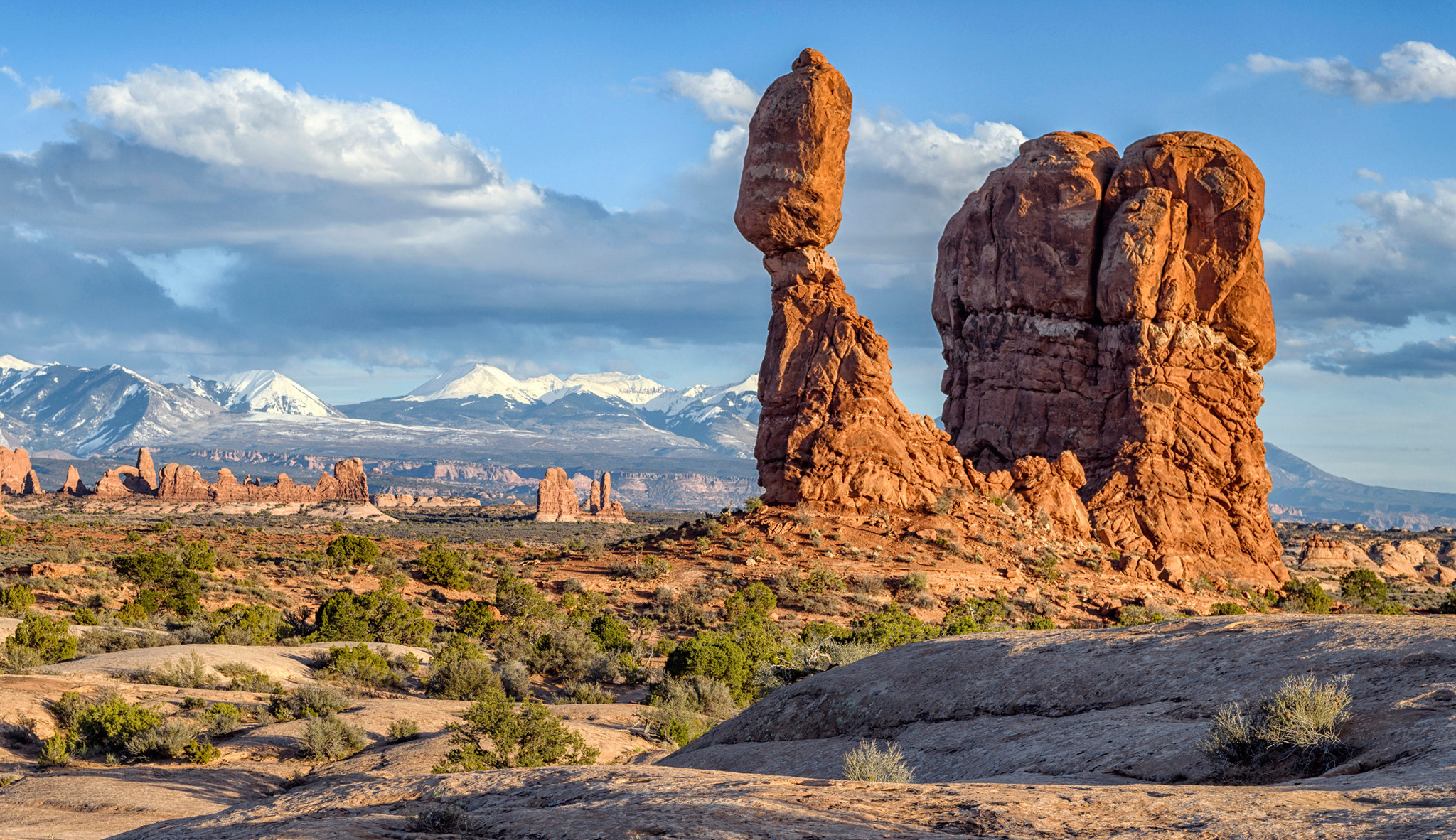
Balanced Rock is a park icon, the 128-ft (39-m) formation looking like it will teeter over at any moment
If you have…
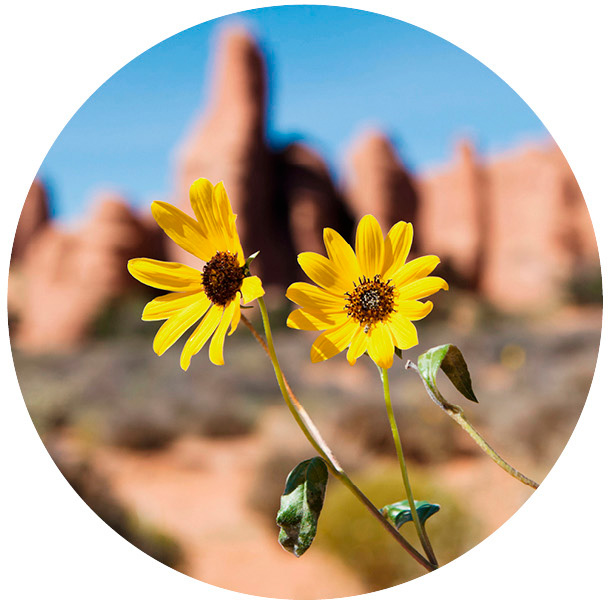
Half a day ▷ The key is to start early. The light is better at sunrise, and the temperature is not too hot for exploring. Do the entire scenic drive, stopping at several viewpoints. Hike to Delicate Arch from Wolfe Ranch or, for a shorter option, to Balanced Rock.

A full day ▷ Keep going after your half-day trek with a hike into the Devils Garden area to see Landscape Arch, the longest arch in North America, as well as Broken Arch. Make a brief stop at the Fiery Furnace viewpoint.

A weekend ▷ Building on the above, camp overnight at Devils Garden for epic stargazing. Early the next day, explore the Windows Section; short trails go to Double Arch, North and South windows, and Turret Arch. Tackle the Courthouse Towers area on your way out, hiking 1 mile (1.6 km) between Park Avenue Viewpoint and Courthouse Towers Viewpoint, then stopping at the paved La Salle Mountain Viewpoint.
FOCUS ON
Artist in the Park
The Park Service runs the Artist in the Park program, in which an artist from the community is selected each year to showcase their talents. The artist sets up shop in prominent locations to share how surrounding nature influences their work. Visitors are encouraged to bring a sketchpad or easel, slow down, and absorb the landscape. The best light in early morning is at Double Arch and Landscape Arch; in late afternoon, it’s at Courthouse Towers, Balanced Rock, and North and South windows.
A pretty picture
The area surrounding Arches National Park is richly adorned in rock wall art, both petroglyphs—images cut, carved, ground, or scratched into rock—and pictographs, paintings made with mineral- and plant-based dye. The park contains a classic example of the former: the Wolfe Ranch panel of petroglyphs at the end of a spur trail off the route to Delicate Arch. The panel shows people on horseback, bighorn sheep, and wolves or dogs. These were likely made by the Ute Indians, who have lived in what is now southeast Utah since the 1200s. No two examples of rock art are the same, but these are typical of the Ute style of the time and contain imagery of horses, which weren’t depicted until after Spanish explorers brought them to North America in 1540. It’s estimated the unique, impressive art was carved between 1650 and 1850.
Another set of rock art is at Courthouse Wash. A panel on the cliff face consisting of both petroglyphs and pictographs follows a style typical of the much older Barrier Canyon Archaic civilization, as seen in the ghostly, elongated human forms and abstract shapes. The white circular shields were probably added later by Ancestral Puebloans or Utes. The forms can be faint and hard to see, but look for them on the surfaces tinted a shiny dark red or black—called “desert varnish,” this darkening of the rock, caused by mineral deposits, made a good painting surface and served as background to the main scene.
Rock art is often found in places like this, where waterways or travel routes meet. Many archeologists believe these images served a purpose beyond the merely decorative—the rock art may have been meant to communicate knowledge and practical wisdom to those who followed in the path of early inhabitants.

Petroglyphs that graffiti the walls of Courthouse Wash convey the local history in images
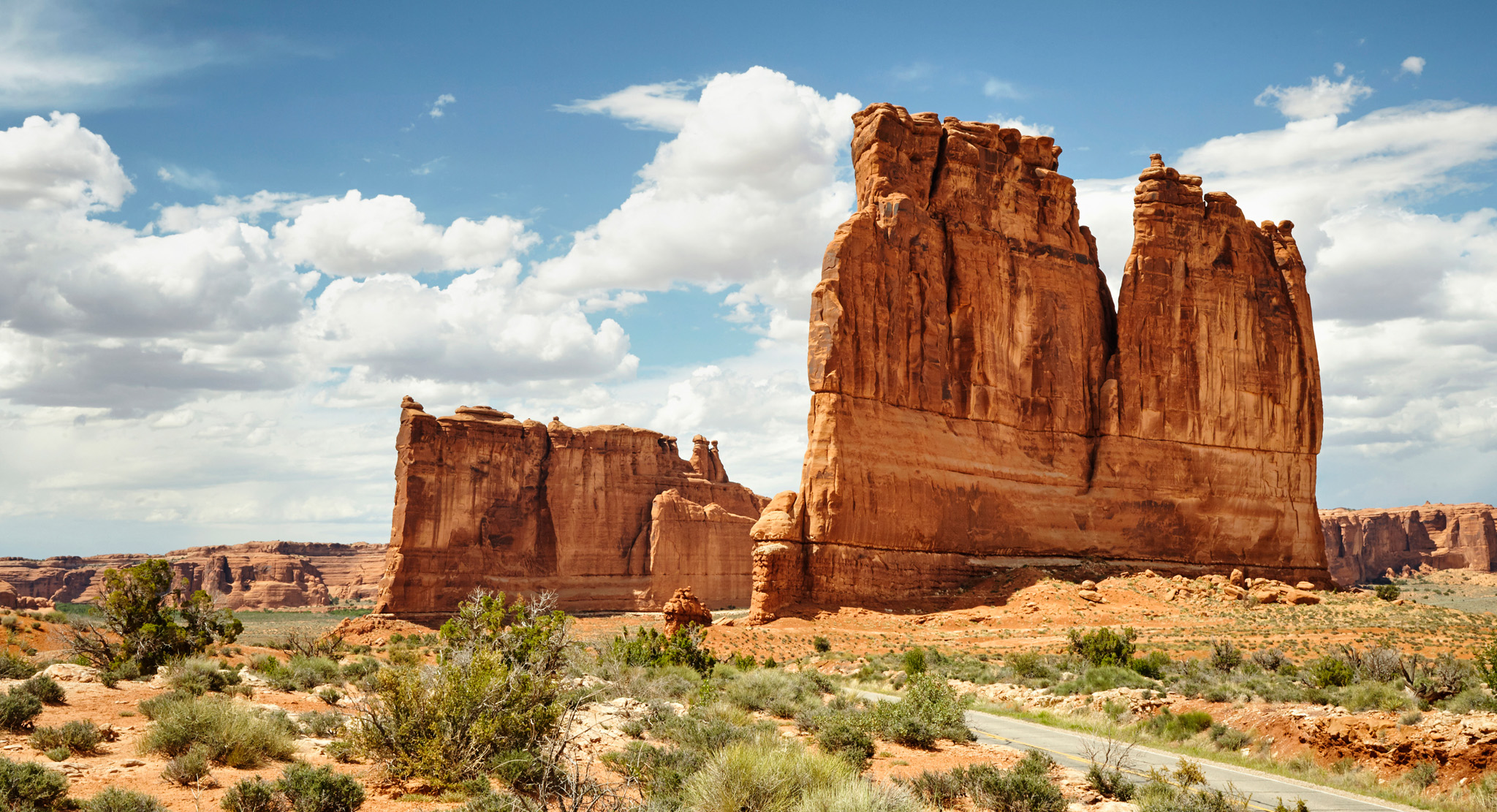
The red sandstone walls stand out in relief against a cotton-cloud sky
History Timeline |
|
|
Human history dates back at least 2,000 years at Arches, when ancestral Puebloans called the area home. It wasn’t until the 20th century that the beauty of the rock formations and the surrounding area was brought to the attention of the National Park Service. |
|
AD 20Ancestral Puebloans establish agricultural villages in and near Arches where they cultivate plants and create rock art panels. |

|
1200sEarly American Indians like the nomadic Shoshoneans (Utes and Paiutes) arrive, leaving petroglyphs at Wolfe Ranch. |
|
1844French-American fur trapper Denis Julien chisels his name and June 9, 1844, into the rock, the first marker of European contact. |
|
1880s–90sWhite farmers and ranchers, including John Wolfe of the Wolfe Ranch, found permanent settlements in the area. |

|
1911Moab newspaper editor Loren Taylor spearheads efforts to preserve the landscape by designating it as a national park. |
|
1929On April 12, 1929, President Herbert Hoover sets aside land in Windows and Devils Garden for Arches National Monument. |
|
1973Geography professor Dale Stevens devises a scientific method for cataloguing the natural arches; about 2,000 have been identified so far. |
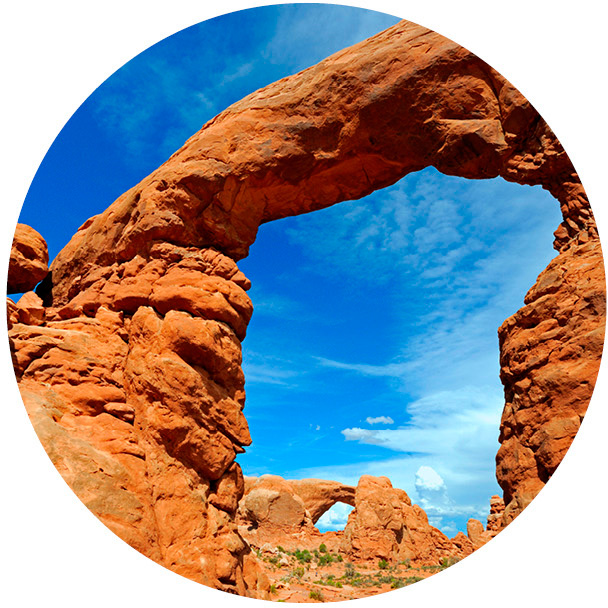
|
Hidden history
The Courthouse Wash panel was vandalized in the 1980s, and while restoring it, scientists found there were more layers of older work hidden beneath the art visible to the naked eye. Infrared photos of the panel revealed previously unseen detail in the hidden layers and added to the mystery surrounding how prehistoric people made the pigments for this artwork. The National Park Service continues to study rock art throughout the area.

Red sandstone cliffs and rock formations line the trails leading to Devils Garden trailhead
Did You Know?
Edward Abbey wrote about his time as an Arches ranger in Desert Solitaire.
Best Hikes

Double Arch ▷ 0.5 miles (1 km) round trip. A family favorite, this short, flat gravel trail ends in a picture-perfect view of two giant arches.
Balanced Rock 0.3 miles (0.5 km) round trip. This easy hike takes in one of the park’s many famous visual delights. The wheelchair-accessible part is paved and leads to a viewpoint of the Windows.

The Windows ▷ 1 mile (1.6 km) round trip. Embark on a gentle climb, mostly on gravel, and take in North Window, South Window, and Turret Arch.
Landscape Arch 1.6 miles (2.5 km) round trip. From Devils Garden trailhead, there’s an hour-long trail to the mighty Landscape Arch, with short spur trails to other formations. For the intrepid, there’s a rougher trail through Devils Garden.
Fiery Furnace 2 miles (3 km) round trip.Explore this otherworldly part of the park, a trail-free labyrinth that involves scrambling over rocks and squeezing through tight sandstone canyons.
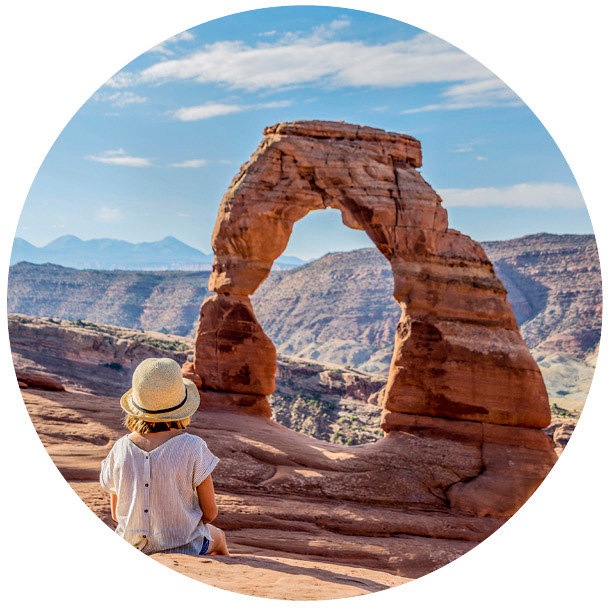
Delicate Arch ▷ 3 miles (5 km) round trip. Journey along an undefined trail, over slick rock and up a steep incline, ending in the improbable beauty of Delicate Arch.
Into the wilderness
Although you can see much of what’s spectacular about the park from roadside overlooks and short hikes, there are plenty of opportunities to venture farther into the landscape and seek peace and quiet. The Devils Garden area has a primitive trail that makes a 7-mile (11-km) loop between Landscape Arch and Double O Arch, which involves some difficult terrain and wayfinding with cairns, but the trade-off is a well-earned sense of solitude. There is one designated backcountry campsite off the Devils Garden primitive trail (permit required). Those with good navigation skills can also travel to allocated overnight sites in the Courthouse Wash area, and it’s possible to backpack in most of the land adjacent to the national park.
Night sky
The chief appeal of spending the night in the backcountry is, of course, those billions of stars above—which, in this remote place, seem close enough to touch. Those who aren’t the rural type can still get a front-row seat by camping overnight at Devils Garden campground or in one of the appointed sites just outside the park.
Camping is not required to appreciate the night sky. Arches National Park was designated an International Dark Sky Park in 2019. Officials make a point of keeping artificial light within the park to a minimum, so light pollution doesn’t block out the incredible blanket of stars. You may be surprised by how many you can see with the naked eye; rangers say that under the right conditions, a pair of binoculars is all you need to see the rings of Saturn. It’s so rare to be in a place without artificial light that you might find yourself as affected by the pure night sky as you were by the spectacular daytime landscape. Beyond the sheer “wow factor,” Arches’ dark sky is especially delightful for night-sky photographers, who can capture that silhouette of eerie rock formations set off by an impossibly vivid Milky Way.
For the best stargazing, plan to visit when there’s a new moon, bring a star map, and use only a red light to find your way around rather than a regular flashlight. The farther north into the park you drive, the darker the sky will be. Panorama Point, the Windows section, the Balanced Rock picnic area, and the Garden of Eden are all great places to stop and stare. In summer, the park offers ranger-led stargazing events, too.
FLORA AND FAUNA
Kangaroo Rats
Their name doesn’t immediately say “adorable,” but these tiny nocturnal mammals are quite cute, as well as impressively well adapted to their harsh desert environment. The seeds they eat provide enough hydration that the rats never need to drink water. Their ears are good enough to hear an owl’s silent approach. And they can leap eight times their body length to escape predators, which include snakes, coyotes, and the aforementioned owls.
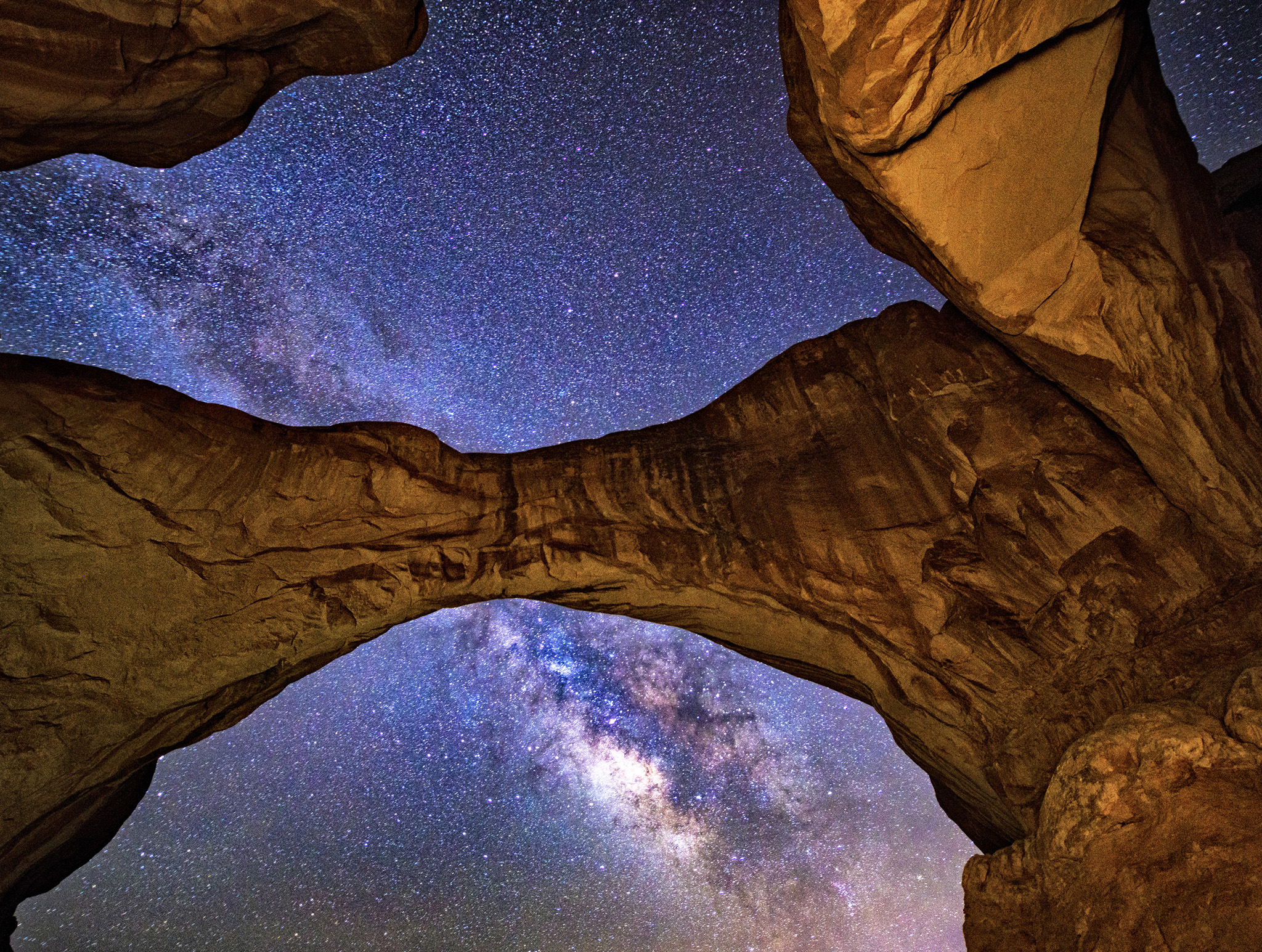
Imagine standing under Double Arch and looking upward into the vastness of the starry Milky Way
